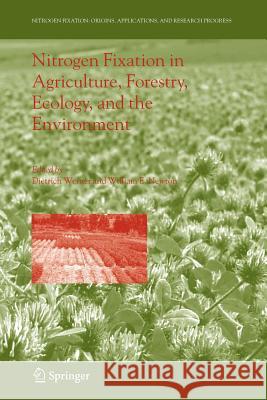Nitrogen Fixation in Agriculture, Forestry, Ecology, and the Environment » książka
Nitrogen Fixation in Agriculture, Forestry, Ecology, and the Environment
ISBN-13: 9789048168972 / Angielski / Miękka / 2010 / 350 str.
Nitrogen Fixation in Agriculture, Forestry, Ecology, and the Environment
ISBN-13: 9789048168972 / Angielski / Miękka / 2010 / 350 str.
(netto: 768,56 VAT: 5%)
Najniższa cena z 30 dni: 771,08
ok. 22 dni roboczych
Bez gwarancji dostawy przed świętami
Darmowa dostawa!
This book is the self-contained fourth volume of a seven-volume comprehensive series on nitrogen fixation. The outstanding aspect of this book is the integration of basic and applied work on biological nitrogen fixation in the fields of agriculture, forestry, and ecology in general. Nowadays, the concept of sustainability, which originated in agriculture and land use, is reaching many other areas of society and industry. Sustainability has a major part to play in the global challenge of continued development of regions, countries, and continents all around the World and biological nitrogen fixation has a key role in this process. This volume begins with chapters specifically addressing crops of major global importance, such as soybeans, rice, and sugar cane. It continues with a second important focus, agroforestry, and describes the use and promise of both legume trees with their rhizobial symbionts and other nitrogen-fixing trees with their actinorhizal colonization. An over-arching theme of all chapters is the interaction of the plants and trees with microbes and this theme allows other aspects of soil microbiology, such as interactions with arbuscular mycorrhizal fungi and the impact of soil-stress factors on biological nitrogen fixation, to be addressed. Furthermore, a link to basic science occurs through the inclusion of chapters describing the biogeochemically important nitrogen cycle and its key relationships among nitrogen fixation, nitrification, and denitrification. The volume then provides an up-to-date view of the production of microbial inocula, especially those for legume crops. No other available work provides the up-to-date and in-depth coverage of this volume, which is intended to serve as an indispensable reference work for academic, government, and industrial scientists working in the applied areas of agronomy, plant breeding, plant nutrition, ecology, and forestry as well as those in the basic science areas of plant physiology, soil microbiology, and related environmental disciplines. This volume will be an invaluable tool for students entering this challenging area of research and will provide science administrators with ready access to vital relevant information.











